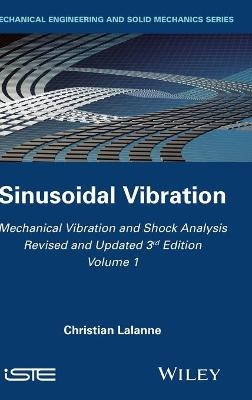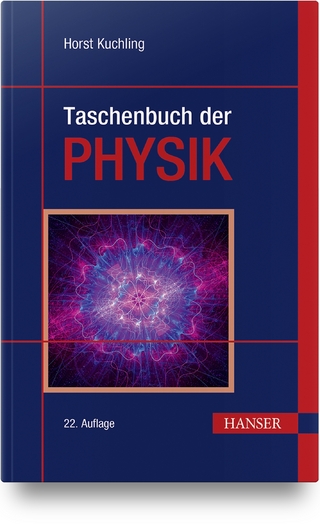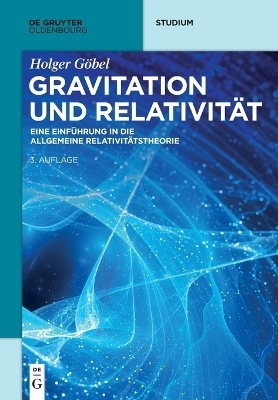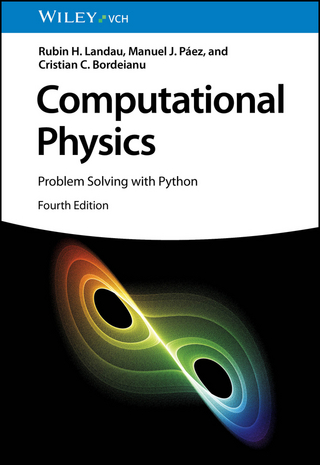
Mechanical Vibration and Shock Analysis, Sinusoidal Vibration
ISTE Ltd and John Wiley & Sons Inc (Verlag)
978-1-84821-644-0 (ISBN)
Everything engineers need to know about mechanical vibration and shock...in one authoritative reference work! This fully updated and revised 3rd edition addresses the entire field of mechanical vibration and shock as one of the most important types of load and stress applied to structures, machines and components in the real world. Examples include everything from the regular and predictable loads applied to turbines, motors or helicopters by the spinning of their constituent parts to the ability of buildings to withstand damage from wind loads or explosions, and the need for cars to maintain structural integrity in the event of a crash. There are detailed examinations of underlying theory, models developed for specific applications, performance of materials under test conditions and in real-world settings, and case studies and discussions of how the relationships between these affect design for actual products.
Invaluable to engineers specializing in mechanical, aeronautical, civil, electrical and transportation engineering, this reference work, in five volumes is a crucial resource for the solution of shock and vibration problems.
The relative and absolute response of a mechanical system with a single degree of freedom is considered for an arbitrary excitation, and its transfer function is defined in various forms. The characteristics of sinusoidal vibration are examined in the context both of the real world and of laboratory tests, and for both transient and steady state response of the one-degree-of-freedom system. Viscous damping and then non-linear damping are considered. The various types of swept sine perturbations and their properties are described and, for the one-degree-of-freedom system, the consequence of an inappropriate choice of sweep rate are considered. From the latter, rules governing the choice of suitable sweep rates are then developed.
Christian Lalanne is a Consultant Engineer who previously worked as an expert at the French Atomic Energy Authority and who has specialized in the study of vibration and shock for more than 40 years. He has been associated with the new methods of drafting testing specifications and associated informatic tools.
Foreword to Series xi
Introduction xv
List of Symbols xix
Chapter 1 The Need 1
1.1 The need to carry out studies into vibrations and mechanical shocks 1
1.2. Some real environments 3
1.2.1. Sea transport 3
1.2.2. Earthquakes 5
1.2.3. Road vibratory environment 6
1.2.4. Rail vibratory environment 7
1.2.5. Propeller airplanes 8
1.2.6. Vibrations caused by jet propulsion airplanes 8
1.2.7. Vibrations caused by turbofan aircraft 9
1.2.8. Helicopters 9
1.3. Measuring vibrations and shocks 11
1.4. Filtering 15
1.4.1. Definitions 15
1.4.2. Digital filters 18
1.5. Digitizing the signal 21
1.5.1. Signal sampling frequency 21
1.5.2. Quantization error 25
1.6. Reconstructing the sampled signal 28
1.7. Characterization in the frequency domain 31
1.8. Elaboration of the specifications 32
1.9. Vibration test facilities 33
1.9.1 Electro-dynamic exciters 33
1.9.2. Hydraulic actuators 37
1.9.3. Test Fixtures 38
Chapter 2 Basic Mechanics 41
2.1. Basic principles of mechanics 41
2.1.1. Principle of causality 41
2.1.2. Concept of force 41
2.1.3. Newton’s first law (inertia principle) 42
2.1.4. Moment of a force around a point 42
2.1.5. Fundamental principle of dynamics (Newton’s second law) 43
2.1.6 Equality of action and reaction (Newton’s third law) 43
2.2. Static effects/dynamic effects 43
2.3. Behavior under dynamic load (impact) 45
2.4. Elements of a mechanical system 48
2.4.1. Mass 48
2.4.2. Stiffness 49
2.4.3. Damping 57
2.4.4. Static modulus of elasticity 71
2.4.5 Dynamic modulus of elasticity 72
2.5. Mathematical models 74
2.5.1. Mechanical systems 74
2.5.2. Lumped parameter systems 75
2.5.3. Degrees of freedom 77
2.5.4. Mode 77
2.5.5. Linear systems 79
2.5.6. Linear one-degree-of-freedom mechanical systems 79
2.6 Setting an equation for n degrees-of-freedom lumped parameter mechanical system 80
2.6.1. Lagrange equations 80
2.6.2. D’Alembert’s principle 88
2.6.3. Free-body diagram 88
Chapter 3 Response of a Linear One-Degree-of-Freedom Mechanical System to an Arbitrary Excitation 97
3.1. Definitions and notation 97
3.2. Excitation defined by force versus time 99
3.3. Excitation defined by acceleration 103
3.4. Reduced form 104
3.4.1 Excitation defined by a force on a mass or by an acceleration of support 104
3.4.2. Excitation defined by velocity or displacement imposed on support 106
3.5. Solution of the differential equation of movement 109
3.5.1. Methods 109
3.5.2. Relative response 109
3.5.3. Absolute response 113
3.5.4. Summary of main results 118
3.6. Natural oscillations of a linear one-degree-of-freedom system 119
3.6.1. Damped aperiodic mode 120
3.6.2. Critical aperiodic mode 124
3.6.3. Damped oscillatory mode 127
Chapter 4 Impulse and Step Responses 145
4.1 Response of a mass–spring system to a unit step function (step or indicial response) 145
4.1.1. Response defined by relative displacement 145
4.1.2 Response defined by absolute displacement, velocity or acceleration 153
4.2. Response of amass–spring system to a unit impulse excitation 158
4.2.1. Response defined by relative displacement 158
4.2.2. Response defined by absolute parameter 164
4.3. Use of step and impulse responses 169
4.4. Transfer function of a linear one-degree-of-freedom system 176
4.4.1. Definition 176
4.4.2 Calculation of H(h) for relative response 179
4.4.3 Calculation of H(h) for absolute response 180
4.4.4. Other definitions of the transfer function 182
4.5. Measurement of transfer function 188
Chapter 5 Sinusoidal Vibration 189
5.1. Definitions 189
5.1.1. Sinusoidal vibration 189
5.1.2. Mean value 191
5.1.3. Mean square value–rms value 192
5.1.4. Periodic vibrations 195
5.1.5. Quasi-periodic signals 198
5.2. Periodic and sinusoidal vibrations in the real environment 199
5.3. Sinusoidal vibration tests 199
Chapter 6 Response of a Linear One-Degree-of-Freedom Mechanical System to a Sinusoidal Excitation 203
6.1. General equations of motion 204
6.1.1 Relative response 204
6.1.2. Absolute response 207
6.1.3. Summary 209
6.1.4. Discussion 210
6.1.5. Response to periodic excitation 212
6.1.6. Application to calculation for vehicle suspension response 213
6.2. Transient response 215
6.2.1. Relative response 215
6.2.2. Absolute response 219
6.3. Steady state response 219
6.3.1. Relative response 219
6.3.2. Absolute response 220
6.4. Responses
6.4.1. Amplitude and phase 221
6.4.2. Variations of velocity amplitude 222
6.4.3. Variations in velocity phase 234
6.5. Responses
6.5.1 Expression for response 235
6.5.2. Variation in response amplitude 236
6.5.3. Variations in phase 241
6.6. Responses
6.6.1 Movement transmissibility 249
6.6.2. Variations in amplitude 250
6.6.3. Variations in phase 253
6.7. Graphical representation of transfer functions 255
6.8 Definitions 257
6.8.1. Compliance–stiffness 257
6.8.2 Mobility – impedance 258
6.8.3. Inertance –mass 259
Chapter 7 Non-viscous Damping 261
7.1. Damping observed in real structures 261
7.2. Linearization of non-linear hysteresis loops – equivalent viscous damping 262
7.3. Main types of damping 266
7.3.1 Damping force proportional to the power b of the relative velocity 266
7.3.2 Constant damping force 267
7.3.3. Damping force proportional to the square of velocity 269
7.3.4 Damping force proportional to the square of displacement 270
7.3.5. Structural or hysteretic damping 271
7.3.6. Combination of several types of damping 272
7.3.7. Validity of simplification by equivalent viscous damping 273
7.4. Measurement of damping of a system 274
7.4.1. Measurement of amplification factor at resonance 274
7.4.2. Bandwidth or √2 method 276
7.4.3. Decreased rate method (logarithmic decrement) 277
7.4.4 Evaluation of energy dissipation under permanent sinusoidal vibration 284
7.4.5. Other methods 288
7.5. Non-linear stiffness 288
Chapter 8 Swept Sine 291
8.1. Definitions 291
8.1.1. Swept sine 291
8.1.2. Octave – number of octaves in frequency interval (f1, f2) 294
8.1.3. Decade 294
8.2. “Swept sine” vibration in the real environment 295
8.3. “Swept sine” vibration in tests 295
8.4. Origin and properties of main types of sweepings 297
8.4.1. The problem 297
8.4.2 Case 1: sweep where time ∆t spent in each interval ∆f is constant for all values of f0 301
8.4.3. Case 2: sweep with constant rate 313
8.4.4. Case 3: sweep ensuring a number of identical cycles ∆N in all intervals ∆f (delimited by the half-power points) for all values of f0 314
Chapter 9 Response of a Linear One-Degree-of-Freedom System to a Swept Sine Vibration 319
9.1. Influence of sweep rate 319
9.2 Response of a linear one-degree-of-freedom system to a swept sine excitation 321
9.2.1. Methods used for obtaining response 321
9.2.2. Convolution integral (or Duhamel’s integral) 322
9.2.3 Response of a linear one-degree-of freedom system to a linear swept sine excitation 324
9.2.4 Response of a linear one-degree-of-freedom system to a logarithmic swept sine 334
9.3. Choice of duration of swept sine test 338
9.4. Choice of amplitude 342
9.5. Choice of sweep mode 343
Appendix Laplace Transformations 353
Vibration Tests: a Brief Historical Background 367
Bibliography 373
Index 387
Summary of Other Volumes in the Series 393
| Erscheint lt. Verlag | 1.4.2014 |
|---|---|
| Reihe/Serie | Mechanical Vibration and Shock Analysis |
| Verlagsort | London |
| Sprache | englisch |
| Maße | 163 x 241 mm |
| Gewicht | 794 g |
| Themenwelt | Naturwissenschaften ► Physik / Astronomie |
| Technik ► Maschinenbau | |
| ISBN-10 | 1-84821-644-0 / 1848216440 |
| ISBN-13 | 978-1-84821-644-0 / 9781848216440 |
| Zustand | Neuware |
| Haben Sie eine Frage zum Produkt? |
aus dem Bereich


